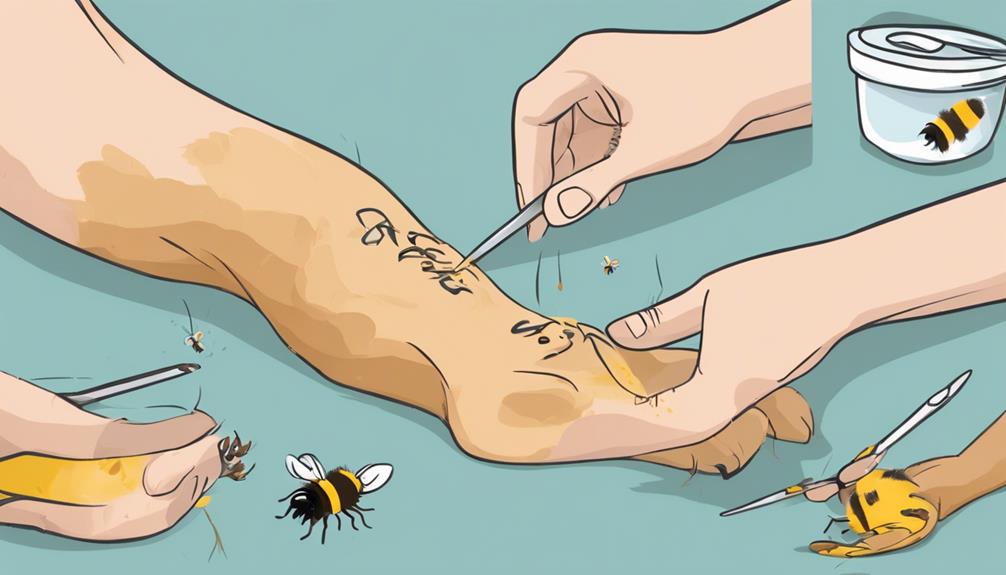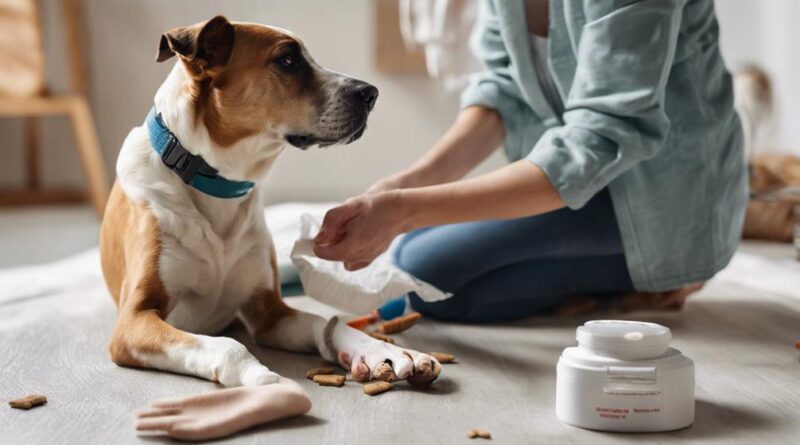What Are Effective First Aid Tips for Dogs?
Ever wondered what you would do if your furry friend needed emergency help?
From recognizing signs of distress to handling minor cuts and scrapes, there are crucial first aid tips every dog owner should know.
But what about more serious situations like treating burns, managing fractures, or responding to heatstroke?
Stay tuned to discover essential techniques that could save your dog's life in an emergency.
Recognizing Signs of Distress
Recognize signs of distress in your dog by observing changes in behavior, such as excessive panting or restlessness. If you notice your furry friend exhibiting these symptoms, it could be a sign of dehydration. To address dehydration, provide your dog with access to fresh water and encourage them to drink. If they aren't responding well or show severe dehydration symptoms like dry gums, sunken eyes, or lethargy, seek veterinary help promptly.
Another crucial aspect of recognizing distress is identifying allergic reactions. Watch out for symptoms like itching, swelling, or hives on your dog's skin. If you suspect an allergic reaction, remove the allergen if possible and consult your vet for appropriate treatment. They may recommend antihistamines or other medications to alleviate your dog's discomfort. Always keep an eye out for any unusual behavior in your furry companion and respond promptly to ensure their well-being.
Handling Minor Cuts and Scrapes
If your dog sustains minor cuts or scrapes, promptly attending to these wounds can prevent infection and aid in their healing process. Here are some essential steps to follow:
- Cleaning wounds: Begin by gently washing the cut or scrape with mild soap and water to remove any dirt or debris that could lead to infection.
- Applying ointment: After cleaning the wound, apply a thin layer of pet-safe antibacterial ointment to help protect the area and promote healing.
- Covering the wound: If the cut is in an area where your dog can easily lick it, consider covering it with a sterile gauze pad and securing it with a bandage or self-adhering wrap to prevent further contamination.
- Monitoring for signs of infection: Keep an eye on the wound for any signs of redness, swelling, discharge, or increased pain, as these could indicate an infection that requires veterinary attention.
Treating Burns and Scalds
When treating burns and scalds on your dog, immediate action is crucial to minimize pain and prevent further damage. Remember, preventing infections is key.
The first step is to cool the affected area. You can gently run cool water over the burn for about 10-15 minutes. Avoid using ice or very cold water as this can worsen the injury. Once the area is cooled, you can lightly pat it dry with a clean cloth.
After cooling the burn, gently apply a small amount of an antiseptic spray or cream to help prevent infections. Keep an eye on the burn for any signs of redness, swelling, or discharge, as these could indicate an infection. If you notice any of these signs, contact your veterinarian promptly.
Dealing With Choking
To assist a choking dog, promptly perform abdominal thrusts following these steps. First, approach the dog calmly but swiftly. Then, kneel behind the dog and place your arms around its waist.
Here's a helpful, unordered list to guide you through this process:
- Heimlich maneuver for dogs: Make a fist with one hand and place it just below the ribcage. Use your other hand to apply pressure.
- Stay alert and focused: Keep a watchful eye on the dog's body language and breathing pattern.
- Paw obstruction prevention: Ensure your dog doesn't have easy access to small objects or toys that could potentially lead to choking.
- Seek veterinary care: Even if you successfully dislodge the obstruction, it's crucial to have your dog checked by a professional to prevent any complications.
Managing Fractures or Sprains
After addressing choking incidents, it's essential to be prepared to handle fractures or sprains in dogs effectively. If you suspect your furry companion has a fracture or sprain, the first step is to keep them calm to prevent further injury. Assess the affected area gently, looking for signs of swelling, deformity, or pain. To provide immediate relief, you can apply a splint to stabilize the limb before transporting them to the vet.
When it comes to pain management, always follow your vet's recommendations regarding medication. They may prescribe pain relievers to keep your dog comfortable during recovery. Additionally, rehabilitation exercises can aid in improving mobility and strength post-injury. These exercises should be performed under the guidance of a professional to prevent any further harm.
Preventive care is crucial in reducing the risk of fractures or sprains in dogs. Ensure your canine companion maintains a healthy weight, receives regular exercise, and stays away from hazardous environments. By taking these precautions, you can help keep your furry friend safe and sound.
Responding to Heatstroke
Maintain vigilance during hot weather to prevent heatstroke in your dog. It's crucial to be proactive in keeping your furry friend safe from overheating. Here are some essential tips to help you combat heatstroke:
- Preventing Overheating: Avoid strenuous activities during the hottest parts of the day to reduce the risk of heatstroke.
- Cooling Techniques: Use damp towels or a cooling vest to bring down your dog's body temperature if they show signs of overheating.
- Hydration: Ensure your dog has access to fresh water at all times to stay hydrated in the heat.
- Shade Strategies: Create shaded areas in your yard or bring a portable canopy when out with your dog to provide relief from direct sunlight.
Handling Insect Bites or Stings

When dealing with insect bites or stings on your dog, swift action is crucial to alleviate discomfort and prevent complications. To prevent bites or stings, consider using dog-safe insect repellents when outdoors.
If your dog gets bitten or stung, immediate care is essential. Start by locating the bite or sting site. If there's a stinger, gently scrape it off sideways using a credit card or your fingernail. Avoid using tweezers as this can squeeze more venom into the skin. Clean the area with mild soap and water to prevent infection. Applying a cold compress can help reduce swelling and provide relief.
Monitor your dog for signs of an allergic reaction, such as difficulty breathing, excessive swelling, or vomiting. If any of these symptoms occur, seek veterinary assistance immediately.
Administering CPR if Necessary
In a critical situation where your dog requires immediate medical attention, knowing how to administer CPR can be life-saving. If you find yourself in a situation where your dog is unresponsive and not breathing, following proper CPR techniques is crucial for their survival.
Here are some key points to remember when performing canine resuscitation as part of your emergency response:
- Check for responsiveness: Before starting CPR, ensure that your dog is unresponsive by gently shaking them and calling their name.
- Clear the airway: Make sure there are no obstructions in your dog's airway that could be preventing them from breathing.
- Start chest compressions: Place your dog on their side and begin chest compressions at a steady pace to help circulate blood flow.
- Provide rescue breaths: After every 30 chest compressions, give two rescue breaths by closing your dog's mouth and breathing into their nose.
Frequently Asked Questions
Can I Use Human First Aid Supplies on My Dog in an Emergency?
In an emergency, it's tempting to use human first aid supplies on your dog. However, it's best to avoid this as pet-specific alternatives are available.
Proper wound cleaning is crucial before applying any treatment. Human medications may not be safe for your dog, so always consult with a veterinarian for advice on how to provide first aid effectively.
How Do I Safely Transport an Injured Dog to the Vet?
When transporting an injured dog to the vet, ensure you use a car restraint to keep them safe.
Have an emergency kit ready with basic supplies.
Call ahead to the animal hospital for professional assistance and guidance.
Gently place the dog in the car, keeping them calm and secure during the journey.
Drive carefully to avoid sudden movements that could worsen the injury.
Are There Any Common Household Items That Are Toxic to Dogs That I Should Be Aware of in Case of an Emergency?
In case of an emergency, it's crucial to know common toxins that are harmful to dogs. Keep items like chocolate, grapes, onions, and xylitol-containing products out of reach. These can be toxic to your furry friend.
Have an emergency plan in place to act quickly if needed. Being prepared can save your dog's life.
What Should I Do if My Dog Is Having a Seizure?
If your dog is having a seizure, stay calm and create a safe space. Avoid touching them during the seizure and make a note of the duration.
Don't try to give medication unless prescribed by a vet. Once the seizure ends, gently comfort them and contact a vet for guidance and diagnosis.
Seizure management and medication should always be under veterinary supervision to ensure the best care for your dog.
How Can I Prevent My Dog From Getting Into Dangerous Situations That May Require First Aid?
To prevent your dog from getting into dangerous situations, start with dog-proofing strategies. Keep hazardous items out of reach and secure cabinets. Use baby gates to block off unsafe areas.
Supervision is key; always keep an eye on your pup, especially around water, electrical cords, and small objects they could swallow. Stay vigilant to avoid emergencies that might require first aid.
Conclusion
In conclusion, being prepared to provide first aid to your furry friend can make a difference in an emergency situation. By recognizing signs of distress, knowing how to handle minor injuries, and being aware of how to respond to more serious issues like heatstroke or choking, you can help keep your dog safe and healthy.
Remember to always consult a veterinarian for any serious or life-threatening emergencies.
